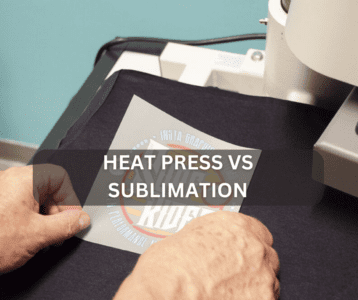
Even though there are multiple similarities between the two, there are also a couple of major differences that set them apart from each other.
Every factor that makes the art of heat press different from sublimation has been shared in the article below in detail. So, it will be easier for you to know which one you need to opt for.
Heat Press vs Sublimation
The below-stated differences are some of the key factors that set the two methods apart from one another.
Major Differences
Procedure
The first and the most common difference between a heat press and sublimation is the difference in procedure. A heat press requires the user to print the design on a sheet of paper and then transfer the design from the paper to an adhesive sheet through the usage of a heat press. The adhesive carrier sheet is then placed onto any substrate and then pressed again for transferring the design. On the contrary, for sublimation, the design is printed onto a sublimation sheet and it is then transferred directly from that sheet to the garment through high heat.
Equipment Needed
Another difference lies between the pieces of equipment required for the two procedures. For the heat press, you need a regular printer and an adhesive carrier sheet. For sublimation printing, you need a special sublimation printer and sublimation paper.
Lifespan Of The Transfer
The transfer of heat press sits on top of the surface, therefore, it may start chipping after a while. However, when a project is designed through sublimation printing, the ink is embedded into the threads of the garment. So, even after multiple uses and washes, the design printed through sublimation does not crack. The design becomes a part of the garment, so it lasts for a longer period. A heat transfer design can last a maximum of 40 washes. On the other hand, sublimation printed design can last even more than 100 washes.
Suitable Substrates
Another difference that makes heat transfer different from sublimation is the variety of substrates. Heat transfer can be done onto any surface. You can heat press ceramics, wood, and even multiple heat-sensitive garments. However, that is not the case for sublimation. Sublimation can only be done onto materials that come with a coating of polyester. If you are using a garment that is a blend of polyester and cotton, then you will not get the vivid results that you always get on pure polyester garments.
Weeding
For heat press, you need to weed out the design. As you transfer the design onto a carrier sheet first, it needs to be weeded out before being placed onto the substrate surface. This is not the case for sublimation transfers. The design is printed directly onto the sheet, so, it does not require any weeding.
Type Of Transfer
In heat transfer, the design sits on top of the garment. As it is a sticker that is pressed to the surface of the garment through the help of adhesive, it lies at the top of the garment. Contrary to that, sublimation uses ink, instead of stickers. In the process of sublimation, the ink sinks into the garment therefore, it becomes a part of the garment itself.
Base Color
The last difference that makes the two procedures differ from one another is that sublimation can only be done on white or light surfaces. You can not sublimate a design on a black or any other dark-colored surface. This condition does not apply to heat press. This procedure can be used on a surface of any color.
Conclusion
No doubt many things put heat press and sublimation in the same category, but there are also some factors that create a stark difference between the two procedures of printing. Every single difference between the two has been discussed in detail in the article above.

I’m Henry Collins and living my happy life. I’m a professional businessman and I own and run 6 Heat Pressing Services stores where I provide my clients with custom Designs on hats, mugs, T-Shirts and a lot more using Heat Press Machine. Been using a heat press for the last 4 years and people love my work. As I’ve got enough information on Heat Press I decided to make a blog on it and share my knowledge with the world. I hope, the world will appreciate it.

